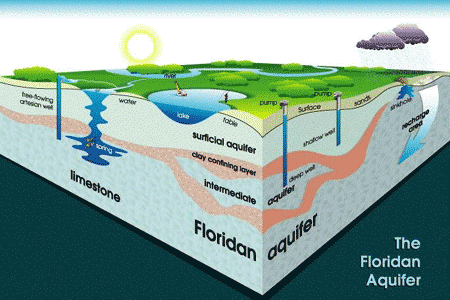Home >>> Water >> Know your watershed
Know your watershed
Your watershed is the land area that catches and contributes water to a water body. Water resources within a watershed are affected by what happens on the land within that watershed. Gainesville's area reaches into multiple watersheds, including the Oklawaha River and the Santa Fe River. Find out about Madera's watershed.
Anything on the land can eventually impact the water resources. In Florida, surface water and ground water are connected through a variety of ways because of the karst landscape.
What is a karst landscape?
Derived from the Slovenian kars, meaning rock, karst landscapes are
underlain by limestone that is easily dissolved by carbonic acid (water
and CO2).
Floridan Aquifer, "Florida's rain barrel"

Aquifers are underground rock and cave systems that hold water. The Floridan Aquifer is one of the most productive aquifers in the world and our main source of drinking water. It reaches across southern Alabama, southeastern Georgia, southern South Carolina and all of Florida and is covered in varying thicknesses of sand, clay, and limestone.
Water in the aquifer is replaced by rainfall that soaks into the ground, a process known as recharge, but this does not occur everywhere. Areas of high recharge include the well-drained sand ridges of central and west-central Florida.
Maintaining natural areas is critical for maintaining water supplies. The sand surface of central Florida is porous, making it easy for water to flow through it and recharge the aquifer. Water cannot soak through the pavement that comes with intense development.


 Sinkholes,
"An aquifer phenomenon"
Sinkholes,
"An aquifer phenomenon" Springs,
"windows to the aquifer"
Springs,
"windows to the aquifer" Lakes
Lakes Rivers
Rivers
 Wetlands
Wetlands